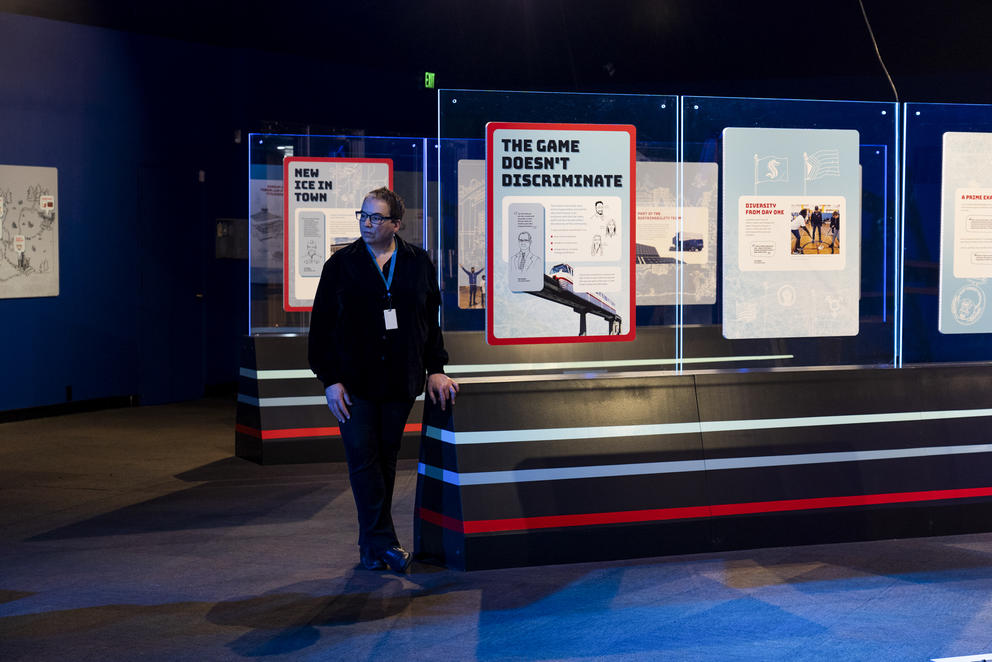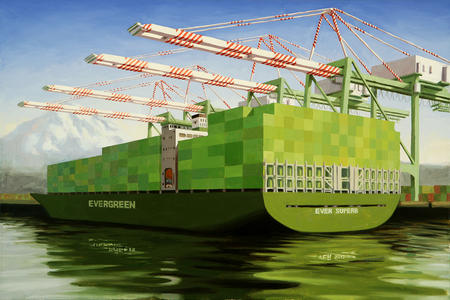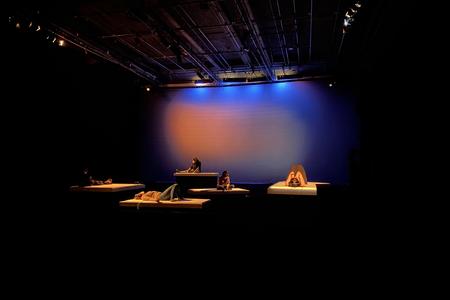The ship, snarled in a major cargo bottleneck in Puget Sound, had been waiting for weeks to get a green light to dock. In the meantime, the ship’s cargo containers — hailing from Australia and filled with a scaled-down replica rink, display cases, hockey sticks and paraphernalia and a complete set of hockey lockers, among other things — had been sitting idly, just out of reach.
The ship finally moored this past Monday, but it’ll still take several more days to arrive — “because of the truck shortage,” says Johns, PacSci’s vice president of exhibits, science education and outreach. The exhibit, originally scheduled to open on Oct. 15, has been postponed twice and is now slated to open Nov. 8. In her 16-year career, Johns has never experienced anything like it. “The word unprecedented has been so overused since COVID-19 hit,” she says, “but it’s yet another example of something unprecedented.”
The supply chain dominoes keep falling, and the Pacific Science Center is not alone in feeling the impacts. Because of surging consumer demand, COVID warehouse closures and a web of other causes, nearly every link in the worldwide supply chain is disrupted. From cardboard and lumber to containers, trucks, workers and even sparkling water, America is, as a recent Atlantic headline put it, “running out of everything.” Ports are clogged, warehouses are filling up, deliveries are late and prices have gone up.
This has upended the tightly regulated schedules of galleries and museums as they scramble for shipments, thrown off the production and delivery of theater and opera stage sets and catapulted book publishers and authors into limbo.
A year and a half into the pandemic, just as they are opening back up, arts organizations are once again finding themselves in a cycle of waiting and seeing, pivoting and planning for an uncertain future. The world is in a crunch, and the arts — already facing slimmed-down budgets and headcounts — are feeling it, too.
“Moving stuff from the gallery to an art fair and then back to the gallery used to be a quick round trip. Now it takes weeks for it all to happen because fewer truckers are servicing more clients,” says longtime Seattle gallerist Greg Kucera. “Shippers seem overwhelmed and impatient.”
Arranging overseas freight shipments is even harder, Kucera says. Long wait times for container reservations mean artwork has to be stored in a climate-controlled warehouse somewhere before final packing. That adds to costs — and prices have already surged, Kucera says: “Everyone is asking for more money, charging surcharges for fuel, and the level of service is slower.”
An additional effect of this slowdown: Galleries risk missing deadlines to get art to clients or up on the walls for exhibits. “We’re working earlier and earlier to make sure material is shipped to the gallery for installations to make hanging deadlines,” Kucera says.
Some gallerists are literally going the extra mile to meet those deadlines. An October show by ceramic artist Jun Kaneko had been in the works for months at Traver Gallery, when gallerist Sarah Traver received a call: Shipping 20 sculptures — some of which are 6.5 feet tall and weigh 650 pounds — from Omaha to Seattle would cost twice as much as planned, and the truck would arrive two days after the show was scheduled to open.
With about a week to go before showtime, Traver booked a last-minute flight to Omaha (traveling with two suitcases full of load straps), rented a 24-foot Penske truck and went on a 3½-day road trip through six states back to Seattle — with more than $500,000 worth of art in tow.
“There are moments when you're going down a windy mountain pass and you're thinking: ‘If the brakes fail, there's an incredible amount of high-value art in the back of this truck’,” Traver says.
Traver appreciates a good road trip — and was able to get the show open on time — but this kind of cross-country self-shipment road race is not something she can or wants to do regularly. Looking ahead to an uncertain future, she says she plans to check in with artists even earlier and build in more buffer time, though this may cost her more in storage rental, if it’s available.
Michael Moore of the Renton-based Arts Tech Group, which creates sets and stages for performance companies across the U.S., has taken a similar approach during this tangle. A recent shipment of a theater set to the East Coast took nearly three times the usual one week. The shipments arrived on time, thanks to advance planning, but Moore says he now considers these kinds of delays “the ‘new normal’ in arts transportation.”
With production schedules for performance dates set months (if not years) in advance, on-time delivery of stage sets — which are often shared or rented out among various organizations — is vital, Moore says. The Los Angeles Opera found out that things were amiss the hard way. In late August, sets for the opera’s season premiere of Il Trovatore got stuck at the port, leaving crews to build a new set in a heart-racing 10 days and adding $300,000 to production costs.
Shipment delays are not the only issue performance-related companies are facing. “As performing arts companies return to live performance … they find themselves waiting in line for many of the same materials used by other fabrication industries,” Moore says. “Shortages of common items such as lumber and steel have resulted in alarming price increases — in some cases, a factor of four or five times the pre-COVID price.” At one point, the three-quarter-inch plywood his company often uses for stage platforms rose from about $40 per sheet up to $140 per sheet, Moore says.
“After nearly two years without paying audiences, the arts now find themselves in a squeeze between diminished funds and significant cost increases,” Moore says.
This means that set builders have to get creative. For one client, Arts Tech Group worked around the lumber price increases by rejigging the design, so that the theater company could reuse older platforms of different size and shape.
The Seattle Opera, meanwhile, has already made multiple material and engineering-related revisions to the set drawings for its all-new production of Orpheus & Eurydice (opening in January) because of rising material costs. Though supply chain issues for sets made in-house like Orpheus & Eurydice may increase costs, Doug Provost, director of production at the Seattle Opera, is most concerned about delays in importing sets from elsewhere.
The just-opened La Bohème skirted such issues because the Seattle Opera owns that set, but the opera plans to import sets for operas debuting next year. “So we still have a few more months. Hopefully, we’ll have some sort of recovery in that sector before it’s going to impact our operations,” Provost says.
Building-material supply chain issues are also impacting galleries and museums, as hardware and other supplies needed for exhibition installation (custom framing, bronze casting, hooks and plywood for crates and transport) are expensive and hard to get.
“To have a crate built right now is 59% — if not 100% — more than it was a year and a half ago,” says Sarah Traver. “Just recently, shipping a piece of glass to a client in New York, I had to say, ‘My shipping estimate has to be completely redone. The shipping costs are higher, the crate costs are higher — it’s going to cost you basically twice as much.’ ”
And certain materials are just not available. Exhibition designers for MoPOP’s new music photography show Contact High: A Visual History of Hip-Hop, opted for Sintra plastic instead of wood panels, and then had to use white when black was not available. The team also had to convert yellow acrylic display elements to a different color because there is a resin shortage, and is now making design alterations to future exhibitions because of a lack of 10-foot plywood.
Local glassblowers are also finding that the colors they want are out of stock — which is particularly challenging when trying to fulfill an order for a client with preapproved colors — as is the clear base glass most pieces start with.
“All that being said, we do our best to get the color our customers want, and they do their best to work with what we have,” says Terri Sullivan, business manager of Hot Glass Color, a downtown glass art supply shop and gallery. “Out of all of it comes beautiful and sometimes surprising glass art.”
But sometimes there’s no option to pivot, only to wait. This is the case for many local authors, book printers and sellers. Paper production has slowed down, which means the book printing process has clogged, and shipping issues have corked the book market. This has pushed up printing costs for art marketing materials, such as program brochures, and added months to standard turnaround times for exhibition catalogs.
“In the past, from copy editing to books arriving at the museum needed about 10 months. Now that is a year. And often that isn’t enough,” says Adrian Lucia, partner at Lucia|Marquand, a local art and architecture book developer and producer. “Those differences in the museum world are hugely impactful, because curators who are working on exhibitions are also trying to orient the exhibition catalog” with the show dates.
Currently, hundreds of exhibition catalogs for Barbara Earl Thomas’ sparkling solo show at the Seattle Art Museum are sitting — you guessed it — in a cargo container. The ship recently docked in Tacoma, but Lucia estimates it’ll be two more weeks before the shipment gets through the port. “It normally would have been sitting in the Seattle Art Museum for six weeks now,” he says.
With no clue whether the issues will be easing up any time soon, Lucia says he’s adjusting his schedules for fall 2022 with these buffer times in mind. “You just have to embrace the uncertainty,” he says.
Get the latest in local arts and culture
This weekly newsletter brings arts news and cultural events straight to your inbox.








